New employee engagement research answers your top 3 questions on overcoming today’s challenging labor market
Published on Jul 14, 2021

The pandemic heavily impacted employment across industries, with many companies resorting to layoffs and furloughs to stay afloat. Today, with a record-high increase in job openings and a tight labor market, many organizations are facing a critical challenge as they struggle to hire new employees and retain current ones.
In a previous blog, we discussed how brands are turning to new employee engagement tactics to attract and retain talent—which has become more critical than ever. To explore this theme further, SMG’s location-based mobile research collected feedback from more than 14,000 respondents to help brands understand current employee expectations and behaviors.
Here are the top 3 questions we answered in our recent study:
1. How has the pandemic impacted employment status + employee priorities?
First let’s get a grasp on overall employment status. Out of the 14,000 we surveyed, 64% of respondents are employed by an organization and 20% are self-employed. Additionally, 8% are unemployed and currently seeking employment; while 8% aren’t currently employed and are not looking for a job. Eleven percent reported being laid off during the pandemic—with the entertainment, restaurant, and manufacturing industries being most impacted.
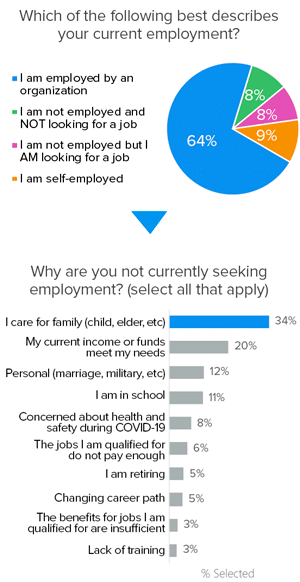
As we dig deeper into those unemployed and not seeking employment, the biggest barrier falls into familial obligations—with 1 in 3 citing caring for a child, elder, or partner as the reason they aren’t looking for a job.
Additionally, when asked the biggest motivator for considering employment opportunities, 70% of respondents said pay, followed by benefits (50%) and schedule (48%).
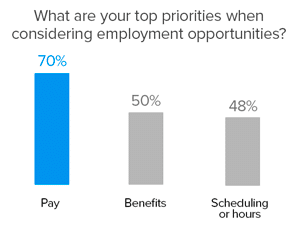
To compete in today’s challenging labor market, organizations must keep these priorities in mind. Those not providing competitive pay will simply be overlooked by prospects. And companies not sensitive to those helping care for family members and refusing to provide flexible schedules or assistance with childcare will lose out to organizations who are considerate of these factors.
2. What can employers do to drive retention of current employees + entice prospects?
Though providing a competitive wage, solid benefits, and a more flexible schedule are important, organizations must also prioritize creating meaningful work for employees. When asked the primary reason for staying with their current employer, job fulfillment was the number one answer at 22%—coming out above pay (20%) and benefits (13%).
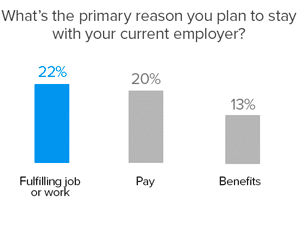
This is especially true for the restaurant industry. Our research shows restaurant employees are most likely to seek a new industry if they intend to leave.
Workers want to connect to their employer’s goals. They want to know they have a place in achieving those goals. They also want to brighten the day for the customers they interact with and know the product or service each customer is buying means something to that customer.
3. How has remote working impacted employment preferences?
For many industries—like retail, restaurant, + healthcare—the majority of employees (68% of respondents from our study) don’t get the option of working from home. These companies require a front-line team. And those front-line employees are still expecting their place of work to prioritize their health + safety—now is not the time to wane on well-being best practices.
However, of the panelists working remotely, 66% said their productivity has increased since they began working from home. And only 1 in 3 said their employer is requiring them to return to work in person full time. Additionally, 90% of employees want some form of remote work.
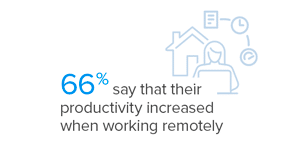
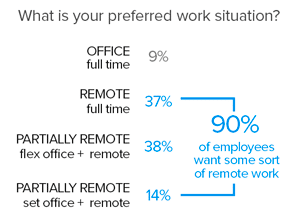
This preference of remote work is a big challenge for service industries. You must do what you can to provide a beneficial experience for front-line teams to compete with work-from-home options.
Provide a differentiated + engaging employee experience
The recent rise in job vacancies means organizations have to work even harder to provide appealing opportunities that not only draw in candidates but promote loyalty and long-term employment.
To prioritize its employee engagement efforts, QSR brand P. Terry’s Burger Stand is leveraging its culture to recruit and retain talent. To learn tactics for attracting candidates, keeping employees engaged, and overcoming labor challenges, watch the video: How P. Terry’s Burger Stand is navigating the challenging labor market.
Related articles

Dodging the Big Quit—Strategies to Answer the Employee Turnover Rate in the Restaurant Industry
Read the blog for effective strategies on how to combat the rising average employee turnover rate in the restaurant industry.

The Impact of Employee Engagement and Labor-Saving Technology on Retail CX
From onboarding best practices to labor-saving technology, this blog is a go-to for retailers looking to improve the employee experience and drive customer loyalty.

Why Voice of the Employee (VoE) matters: Turning feedback into action
Empowered employees drive business success. Discover why Voice of the Employee (VoE) is essential for engagement, retention, and customer satisfaction—and how to turn employee feedback into meaningful